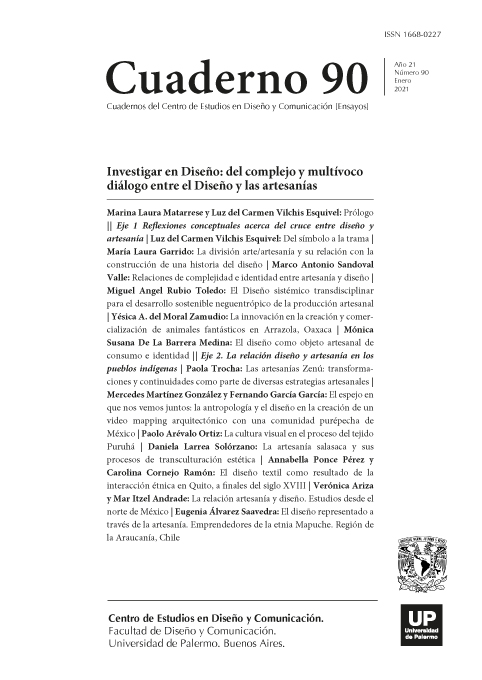Del símbolo a la trama
Abstract
The commitment of many Latin American ethnic groups has been the vindication of the textile plastic expressions in a range that is quite their own, insofar as they submit themselves to the idea of opening surpluses of meaning instead of just representing or imitating a shape or an object. The indigenous textiles, besides the material characterization, subscribed to the qualities of the thread in its capacity to be woven, and to the fiber, in the diversity of configurations of the plot, are conditioned by the supernatural, the extraordinary, that is outside the world observable. The textile craft has established from its traditional processes, innumerable rhetorical relationships, especially metaphorical, between the image and textile materiality, assuming its characteristics, contextual relations and alternative displacement. They are therefore recurrent, the processes that take to the textile art towards mythical senses, identified mainly with sacred narrations that explain the world and the humanity; They are moral and religious examples, which are presented to us as if they were absolute and immovable truths in a frequently ritual context, and the taboo, a Polynesian word that integrates the meanings of the sacred, the untouchable, the forbidden and the malignant, those ideas that under no circumstances should be transgressed together with the reverential fear of a supernatural force that imposes terrible punishments on the offender. This concept has opened the doors of the metaphysical and the ontological, leading artisans to a profound interpretative exercise that has oscillated between superstition and caution before the unknown, marking as a constant the contradictions that this implies, the meaning of the opposites express in triscaidecafobia-triscaidecafilia, sympathy and aversion, the profane and the sacred imposed on objects with a unique expressive force.
References
Auza Aramaya, V. (2010) Una mueca de la feminidad jalq’a- Los cuerpos monstruosos en el tacto sublimado del textil. Tinkazos. Revista Boliviana de Ciencias Sociales. La Paz: Programa de Investigaciones Estratégicas de Bolivia, 28: 131-142.
Balzat, O. (Ed.) (2002) Le concept d’identité. Vivre ensemble autrement. Bélgica: Annoncer le Colueur /CBAI / CGE / Info-Sud Belgique / ITECO, p. 41-44.
Beuchot, M. (2004) Hermenéutica. Analogía y símbolo. México: Herder.
Beuchot, M. (1999) Las caras del símbolo: el ícono y el ídolo. Madrid: Caparrós Editores.
Castañeda, M. J. (2016) Arte textil y bordados indígenas de México, una guía para distinguir los distintos tipos, https://masdemx.com/2016/07/arte-textil-y-bordados-indigenas-demexico-una-guia-para-distinguir-los-distintos-tipos/
Cid, A. (2010) La imagen del indígena a partir de la lectura de los documentos glíficos del siglo XVI en El indígena en el imaginario iconográfico. México: Comisión Nacional para el Desarrollo de los pueblos indígenas / Programa de las Naciones Unidas para el Desarrollo.
Cumes, A. (2018) La presencia subalterna en la investigación social: reflexiones a partir de una experiencia de trabajo. Leyva, X.J. y otros. Prácticas otras de conocimiento(s). Entre crisis, entre guerras. Buenos Aires: CLACSO / Chiapas Cooperativa Retos / Lima: PDTG / Copenhague: IWGIA / Habana: Talleres Galfisa / Coimbra: Proyecto Alice / Guadalajara: Taller La Casa del Mago, p. 135-158.
De Ávila B. A. (2000) Hebras de diversidad. Los textiles de Oaxaca en contexto en Kathryn Klein (Editora) El hilo continuo. La conservación de las tradiciones textiles de Oaxaca. USA: Paul Getty Museum.
Durand, G. (1997) La imaginación simbólica. Buenos Aires: Amorrortu. (Colección Biblioteca de Filosofía).
Eliade, M. (2001) El mito del eterno retorno. Arquetipos y repetición. Buenos Aires: Emecé.
Frame, M. (1994) Las imágenes visuales de estructuras textiles en el arte del antiguo Perú en Estudios y Debates. Revista Andina. 12 (2): 295-372.
Giddens, A. (1990) The Consequences of Modernity. Cambridge: Polity Press. Heidegger, M. (1990) Identidad y diferencia. Barcelona: Anthropos. Igoe, E. (2010) The tacit turn – Textile design in design research. London: Royal College of Art / London and University Portsmouth.
Jung, C.G. (2003) Arquetipos e inconsciente colectivo. Barcelona: Paidós. Kerényi, K. y otros (1994) Arquetipos y símbolos colectivos. Barcelona: Anthropos.
Klein, K. (2000) El hilo continuo. La conservación de las tradiciones textiles de Oaxaca. USA: Paul Getty Museum.
Le Guern, M. (1973) La metáfora y la metonimia, Madrid: Cátedra. León Vega, E. (2001) De filias y arquetipos. La vida cotidiana en el pensamiento moderno de Occidente. México: UNAM.
Marcuse, H. y otros (1989) A la búsqueda del sentido. Salamanca: Sígueme
Magariños de Morentín, J. (2008) La semiótica de los bordes. Apuntes de metodología semiótica. Buenos Aires: Comunicarte Editorial.
Ortiz-Osés, A. (1999) Cuestiones fronterizas. Una filosofía simbólica. Barcelona: Anthropos (Colección Biblioteca A, conciencia , 34).
Palazón, M. R. (2001) Las interpretaciones del mito en M. Beuchot y A. Velasco, Perspectiva y horizontes de la hermenéutica en las humanidades, el arte y las ciencias. México: UNAM.
Paul, A. (1990) Paracas ritual attire: symbols of authority in ancient Peru. Civilization of the American Indian Series. Norman: University of Oklahoma Press.
Porfirio, S. (2017) Textiles del Sur. Aproximación semiótica Cuaderno 9. La Plata: Facultad de Ciencias Naturales y Museo Cátedra.
Todorov, T. (1993) Simbolismo e interpretación. Venezuela: Monte Ávila Editores.
Trevi, M. (1996) Metáforas del símbolo. Barcelona: Anthropos.
Vilchis Esquivel, L. del C. (2006) Relaciones dialógicas en el Diseño Gráfico. México: UNAM.
Zecchi, S. (1990) La Belleza. Madrid: Tecnos.
Los autores/as que publiquen en esta revista ceden los derechos de autor y de publicación a "Cuadernos del Centro de Estudios de Diseño y Comunicación", Aceptando el registro de su trabajo bajo una licencia de atribución de Creative Commons, que permite a terceros utilizar lo publicado siempre que de el crédito pertinente a los autores y a esta revista.


